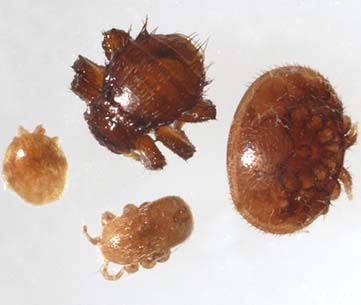 by Véto-pharma
by Véto-pharma Mellitiphis alvearius, the elusive pollen mite, raises a question: Is it a new threat?
Mellitiphis alvearius, commonly known as the pollen mite, is a tiny arachnid that inhabits bee hives. Despite its small size, about half the size of a varroa mite, it can be significant in its impact on hive ecology.


Mellitiphis alvearius has a wide distribution range, being found across Europe, the United Kingdom, New Zealand, Korea, and various regions in North and South America.1,2
Within the hive, Mellitiphis alvearius is commonly found in the adult phase. Unlike parasitic mites such as varroa and Tropilaelaps, Mellitiphis alvearius prefers to feed on fallen pollen balls rather than bee brood or eggs. This dietary preference earned it the nickname “pollen mite.”
The adult Mellitiphis alvearius mite is light brown in color and measures approximately 0.75 mm (0.029 inches) in size. Despite its small stature, it can be observed within the hive, often on the bottom where fallen pollen accumulates.3

Due to its size and appearance, Mellitiphis alvearius can sometimes be mistaken for Tropilaelaps, a harmful parasitic mite native to Asia. However, unlike Tropilaelaps, Mellitiphis alvearius remains a saprophytic mite, not deemed harmful to honey bee colonies.4
Studies suggest that Mellitiphis alvearius is relatively uncommon in honeybee hives. For example, in Central Europe, it was found in only 5.5% of sampled hives5, while in other regions like New Zealand, its presence may be more widespread.3
Understanding the role of Mellitiphis alvearius within the hive ecosystem not only enriches our knowledge but also can help beekeepers better manage their colonies and detect potential issues early on.
Do you want more info? Here are some links that could be interesting for you:
References:
 by Ulrike Marsky
by Ulrike Marsky  by Juan Molina
by Juan Molina Join the Véto-pharma community and receive our quarterly newsletter as well as our occasional beekeeping news. You can unsubscribe at any time if our content does not suit you, and your data will never be transferred to a third party!
© 2019-2025, Véto-pharma. All rights reserved